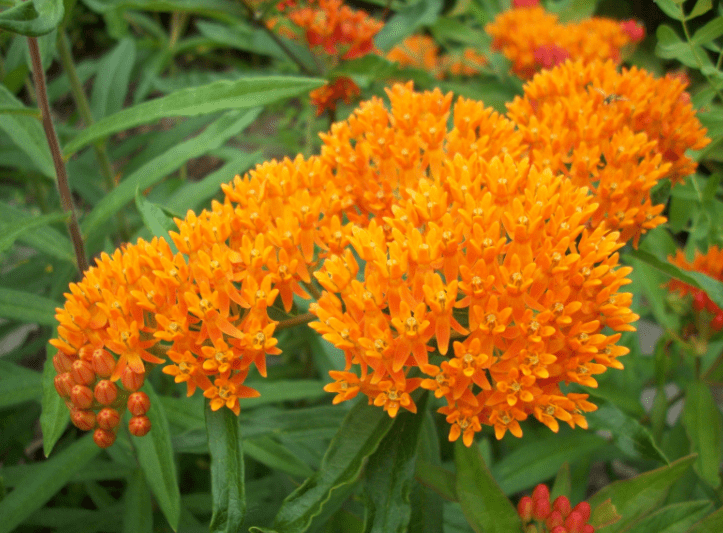Milkweed
What’s the hottest perennial plant for 2022? Milkweed! Gardeners across the Maritimes have been adding clumps of milkweed to their ornamental beds and borders to help support monarch butterflies.
This plant is essential because it’s the sole monarch butterfly host plant. That means monarchs only lay their eggs on milkweed plants. No milkweed, no monarchs.
The various species are also beautiful plants that flower for weeks each summer. When the plants bloom, the nectar-rich flowers attract butterflies and bees, beneficial insects, and other pollinators.
Types Of Milkweed
There are many species you can plant, but I suggest sticking to native species like common and swamp milkweed. These are native to Nova Scotia, New Brunswick, Prince Edward Island, and other Canadian provinces.
The common variety is a hardy perennial native to eastern North America and grows three to five feet tall. It has large bright green leaves and rounded flowers that range from cream to pink.
Be warned; this plant spreads quickly and enthusiastically via rhizomes, underground stems. It also self-seeds. It’s best to plant it in a raised bed where its spread can be contained.
Although the monarch butterflies may disagree, common milkweed is classified as an aggressive weed in Nova Scotia.
As its name suggests, the Swamp variety does grow in areas with moist soil, but it can also be planted in regular soil in garden beds. It grows three to four feet tall with beautiful flat-topped pink flowers.
It’s pretty well-behaved, unlike common variety, and forms clumps in the garden. It’s considered one of the easiest species to grow and is an incredibly ornamental garden plant.
Butterfly weed is another sort sold widely in garden centers but native to Nova Scotia. That said, I have many clumps of this plant and love the bright orange, flat-topped flowers.
It raises two to three feet tall and doesn’t spread aggressively. However, it’s not the top choice for a monarch butterfly. They will lay eggs on it, but if common or swamp milkweed is nearby, they typically choose to lay eggs on those species instead.
Where To Buy
These plants are widely available at nurseries and greenhouses, or you can buy seeds to grow your own. I usually start milkweed seeds indoors under grow lights in March, transplanting the seedlings to the garden in late May. In autumn, I also gather plants seedpods and scatter the seeds throughout my garden beds.
How much of it do you need to plant for monarch butterflies? I like to grow in large clumps to make the plants more noticeable to the butterflies. Clustering three to four plants together has been very effective for me.
I’ve also created a new pollinator garden that is 20 feet by 10 feet and has planted half of it with swamp milkweed and butterfly weed.
Watch For Caterpillars
If you’re going to plant it, you’ll need to know how to identify monarch caterpillars. They’re enormous with bold black, white, and yellow stripes. Their job is to eat your milkweed, so don’t panic if you notice the plants being defoliated by monarch caterpillars.
That’s why you planted it and why it’s good to have several plants. This is a hardy perennial, and the plants will recover and return.
Plant Profile: Scarlet Milkweed
Asclepias curassavica
- Growth habit: An upright evergreen perennial growing to 3 feet tall.
- Light: Plant in full sun to lightly shaded locations.
- Water needed: Drought tolerant; grows best with weekly waterings.
- Feedings: Employ a stabilized fertilizer later in March, June, and September.
- Multiplication: Create fresh plants from seeds or cuttings.
- Ease of culture: Easy.
- Hardiness: Hardy; frosts and freezing weather may damage stems, but shoots grow back from the base.
- Use: A good plant for the butterfly garden or perennial flower bed. It Opens year-round clusters of bright orange and yellow blossoms.
Plants often grow a bit lean and need periodic pruning to remain compact. Aphids also feed in the new growths and can be controlled with soap sprays.























